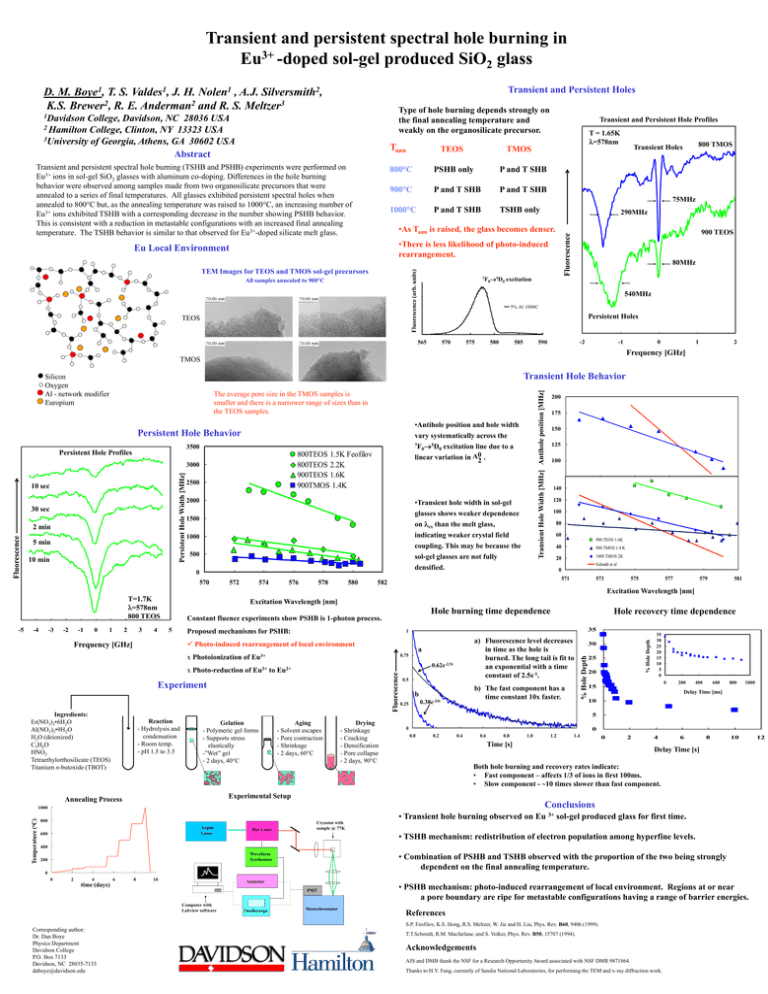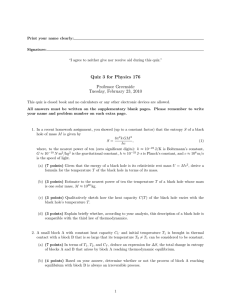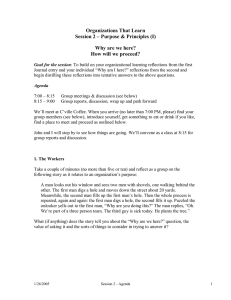Transient and Persistent Spectral Hole Burning in Eu 3+ -Doped Sol-Ge
advertisement

Transient and persistent spectral hole burning in 3+ Eu -doped sol-gel produced SiO2 glass Transient and Persistent Holes D. M. Boye1, T. S. Valdes1, J. H. Nolen1 , A.J. Silversmith2, K.S. Brewer2, R. E. Anderman2 and R. S. Meltzer3 Type of hole burning depends strongly on the final annealing temperature and weakly on the organosilicate precursor. 1Davidson College, Davidson, NC 28036 USA 2 Hamilton College, Clinton, NY 13323 USA 3University of Georgia, Athens, GA 30602 USA Abstract Tann Transient and persistent spectral hole burning (TSHB and PSHB) experiments were performed on Eu3+ ions in sol-gel SiO2 glasses with aluminum co-doping. Differences in the hole burning behavior were observed among samples made from two organosilicate precursors that were annealed to a series of final temperatures. All glasses exhibited persistent spectral holes when annealed to 800C but, as the annealing temperature was raised to 1000C, an increasing number of Eu3+ ions exhibited TSHB with a corresponding decrease in the number showing PSHB behavior. This is consistent with a reduction in metastable configurations with an increased final annealing temperature. The TSHB behavior is similar to that observed for Eu3+-doped silicate melt glass. TEOS Transient and Persistent Hole Profiles T = 1.65K =578nm TMOS 800°C PSHB only P and T SHB 900°C P and T SHB P and T SHB 75MHz 1000°C P and T SHB TSHB only 290MHz •There is less likelihood of photo-induced rearrangement. Fluorescence (arb. units) TEM Images for TEOS and TMOS sol-gel precursors All samples annealed to 900°C TEOS 7F 5D 0 0 900 TEOS Fluorescence •As Tann is raised, the glass becomes denser. Eu Local Environment 80MHz excitation 540MHz 5% Al 1000C Persistent Holes 565 570 575 580 585 -2 590 -1 0 1 2 Frequency [GHz] TMOS Transient Hole Width [MHz] Antihole position [MHz] Transient Hole Behavior Silicon Oxygen Al - network modifier Europium The average pore size in the TMOS samples is smaller and there is a narrower range of sizes than in the TEOS samples. •Antihole position and hole width vary systematically across the 7F 5D excitation line due to a 0 0 linear variation in A02 . Persistent Hole Behavior 0 3500 Persistent Hole Profiles 800TEOS 1.5K Feofilov 800TEOS 2.2K 900TEOS 1.6K 900TMOS 1.4K Persistent Hole Width [MHz] 3000 10 sec 30 sec 2 min Fluorescence 800 TMOS Transient Holes 5 min 10 min 2500 2000 •Transient hole width in sol-gel glasses shows weaker dependence on ex than the melt glass, indicating weaker crystal field coupling. This may be because the sol-gel glasses are not fully densified. 1500 1000 500 0 570 572 574 576 578 580 200 175 150 125 100 75 160 140 120 100 80 60 900 TEOS 1.6K 40 900 TMOS 1.4 K 20 1000 TMOS 2K Schmidt et al 0 571 582 573 575 577 579 581 Excitation Wavelength [nm] T=1.7K =578nm 800 TEOS -2 -1 0 1 2 3 4 Constant fluence experiments show PSHB is 1-photon process. 5 Proposed mechanisms for PSHB: 35 1 Photo-induced rearrangement of local environment Frequency [GHz] a) Fluorescence level decreases in time as the hole is burned. The long tail is fit to an exponential with a time constant of 2.5s-1. a 0.75 x Photoionization of Eu3+ 0.62e-2.5t Fluorescence x Photo-reduction of Eu3+ to Eu2+ Experiment Ingredients: Er(NO3)3•6H2O Al(NO3)3•9H2O H2O (deionized) C3H6O HNO3 Tetraethylorthosilicate (TEOS) Titanium n-butoxide (TBOT) Hole recovery time dependence 0.5 b) The fast component has a time constant 10x faster. b 0.38e-24t 0.25 % Hole Depth -3 Hole burning time dependence 30 % Hole Depth -4 25 20 35 30 25 20 15 10 5 0 0 15 200 400 600 800 1000 Delay Time [ms] 10 5 Reaction - Hydrolysis and condensation - Room temp. - pH 1.5 to 3.5 Gelation - Polymeric gel forms - Supports stress elastically -”Wet” gel - 2 days, 40°C Aging - Solvent escapes - Pore contraction - Shrinkage - 2 days, 60°C Drying - Shrinkage - Cracking - Densification - Pore collapse - 2 days, 90°C 0 0 0.0 0.2 0.4 0.6 0.8 1.0 1.2 1.4 0 2 Time [s] 4 6 8 10 Delay Time [s] Both hole burning and recovery rates indicate: • Fast component – affects 1/3 of ions in first 100ms. • Slow component - ~10 times slower than fast component. Experimental Setup Annealing Process Conclusions 1000 Temperature (oC) -5 Excitation Wavelength [nm] • Transient hole burning observed on Eu 3+ sol-gel produced glass for first time. 800 Argon Laser 600 Dye Laser Cryostat with sample @ 77K • TSHB mechanism: redistribution of electron population among hyperfine levels. 400 • Combination of PSHB and TSHB observed with the proportion of the two being strongly dependent on the final annealing temperature. Waveform Synthesizer 200 0 0 2 4 6 8 10 Ammeter time (days) PMT Computer with Labview software Oscilloscope Monochromator • PSHB mechanism: photo-induced rearrangement of local environment. Regions at or near a pore boundary are ripe for metastable configurations having a range of barrier energies. References S.P. Feofilov, K.S. Hong, R.S. Meltzer, W. Jia and H. Liu, Phys. Rev. B60, 9406 (1999). Corresponding author: Dr. Dan Boye Physics Department Davidson College P.O. Box 7133 Davidson, NC 28035-7133 daboye@davidson.edu T.T.Schmidt, R.M. Macfarlane, and S. Volker, Phys. Rev. B50, 15707 (1994). Acknowledgements AJS and DMB thank the NSF for a Research Opportunity Award associated with NSF DMR 9871864. Thanks to H.Y. Fang, currently of Sandia National Laboratories, for performing the TEM and x-ray diffraction work. 12 Transient and persistent spectral hole burning in 3+ Eu -doped sol-gel produced SiO2 glass Transient and Persistent Holes D. M. Boye1, T. S. Valdes1, J. H. Nolen1 , A.J. Silversmith2, K.S. Brewer2, R. E. Anderman2 and R. S. Meltzer3 Type of hole burning depends strongly on the final annealing temperature and weakly on the organosilicate precursor. 1Davidson College, Davidson, NC 28036 USA 2 Hamilton College, Clinton, NY 13323 USA 3University of Georgia, Athens, GA 30602 USA Abstract Tann Transient and persistent spectral hole burning (TSHB and PSHB) experiments were performed on Eu3+ ions in sol-gel SiO2 glasses with aluminum co-doping. Differences in the hole burning behavior were observed among samples made from two organosilicate precursors that were annealed to a series of final temperatures. All glasses exhibited persistent spectral holes when annealed to 800C but, as the annealing temperature was raised to 1000C, an increasing number of Eu3+ ions exhibited TSHB with a corresponding decrease in the number showing PSHB behavior. This is consistent with a reduction in metastable configurations with an increased final annealing temperature. The TSHB behavior is similar to that observed for Eu3+-doped silicate melt glass. TEOS Transient and Persistent Hole Profiles T = 1.65K =578nm TMOS 800°C PSHB only P and T SHB 900°C P and T SHB P and T SHB 75MHz 1000°C P and T SHB TSHB only 290MHz •There is less likelihood of photo-induced rearrangement. Fluorescence (arb. units) TEM Images for TEOS and TMOS sol-gel precursors All samples annealed to 900°C TEOS 7F 0 5D 0 900 TEOS Fluorescence •As Tann is raised, the glass becomes denser. Eu Local Environment 80MHz excitation 540MHz 5% Al 1000C Persistent Holes 565 570 575 580 585 -2 590 -1 0 1 2 Frequency [GHz] TMOS Transient Hole Width [MHz] Antihole position [MHz] Transient Hole Behavior Silicon Oxygen Al - network modifier Europium The average pore size in the TMOS samples is smaller and there is a narrower range of sizes than in the TEOS samples. •Antihole position and hole width vary systematically across the Persistent Hole Behavior 0 7F 3500 Persistent Hole Profiles Persistent Hole Width [MHz] 10 sec 30 sec 2 min 5 min 10 min 2500 0 5D 0 excitation line due to a linear variation in A 02 . 800TEOS 1.5K Feofilov 800TEOS 2.2K 900TEOS 1.6K 900TMOS 1.4K 3000 Fluorescence 800 TMOS Transient Holes 2000 •Transient hole width in sol-gel glasses shows weaker dependence 1500 on ex than the melt glass, indicating weaker crystal field coupling. This may be because the sol-gel glasses are not fully densified. 1000 500 0 570 572 574 576 578 580 200 175 150 125 100 160 75 140 120 100 80 60 900 TEOS 1.6K 40 900 TMOS 1.4 K 20 1000 TMOS 2K Schmidt et al 0 571 582 573 575 577 579 581 Excitation Wavelength [nm] T=1.7K =578nm 800 TEOS -2 -1 0 1 2 3 4 Constant fluence experiments show PSHB is 1-photon process. 5 Proposed mechanisms for PSHB: 35 1 Photo-induced rearrangement of local environment Frequency [GHz] a) Fluorescence level decreases in time as the hole is burned. The long tail is fit to an exponential with a time constant of 2.5s-1. a 0.75 x Photoionization of Eu3+ 0.62e-2.5t Fluorescence x Photo-reduction of Eu3+ to Eu2+ Experiment Ingredients: Er(NO3)3•6H2O Al(NO3)3•9H2O H2O (deionized) C3H6O HNO3 Tetraethylorthosilicate (TEOS) Titanium n-butoxide (TBOT) Hole recovery time dependence 0.5 b) The fast component has a time constant 10x faster. b 0.38e-24t 0.25 % Hole Depth -3 Hole burning time dependence 30 % Hole Depth -4 25 20 35 30 25 20 15 10 5 0 0 15 200 400 600 800 1000 Delay Time [ms] 10 5 Reaction - Hydrolysis and condensation - Room temp. - pH 1.5 to 3.5 Gelation - Polymeric gel forms - Supports stress elastically -”Wet” gel - 2 days, 40°C Aging - Solvent escapes - Pore contraction - Shrinkage - 2 days, 60°C Drying - Shrinkage - Cracking - Densification - Pore collapse - 2 days, 90°C 0 0 0.0 0.2 0.4 0.6 0.8 1.0 1.2 1.4 0 2 Time [s] 4 6 8 10 Delay Time [s] Both hole burning and recovery rates indicate: • Fast component – affects 1/3 of ions in first 100ms. • Slow component - ~10 times slower than fast component. Experimental Setup Annealing Process Conclusions 1000 Temperature (oC) -5 Excitation Wavelength [nm] • Transient hole burning observed on Eu 3+ sol-gel produced glass for first time. 800 Argon Laser 600 Dye Laser Cryostat with sample @ 77K • TSHB mechanism: redistribution of electron population among hyperfine levels. 400 • Combination of PSHB and TSHB observed with the proportion of the two being strongly dependent on the final annealing temperature. Waveform Synthesizer 200 0 0 2 4 6 8 10 Ammeter time (days) PMT Computer with Labview software Oscilloscope Monochromator • PSHB mechanism: photo-induced rearrangement of local environment. Regions at or near a pore boundary are ripe for metastable configurations having a range of barrier energies. References S.P. Feofilov, K.S. Hong, R.S. Meltzer, W. Jia and H. Liu, Phys. Rev. B60, 9406 (1999). Corresponding author: Dr. Dan Boye Physics Department Davidson College P.O. Box 7133 Davidson, NC 28035-7133 daboye@davidson.edu T.T.Schmidt, R.M. Macfarlane, and S. Volker, Phys. Rev. B50, 15707 (1994). Acknowledgements AJS and DMB thank the NSF for a Research Opportunity Award associated with NSF DMR 9871864. Thanks to H.Y. Fang, currently of Sandia National Laboratories, for performing the TEM and x-ray diffraction work. 12




